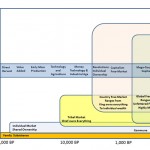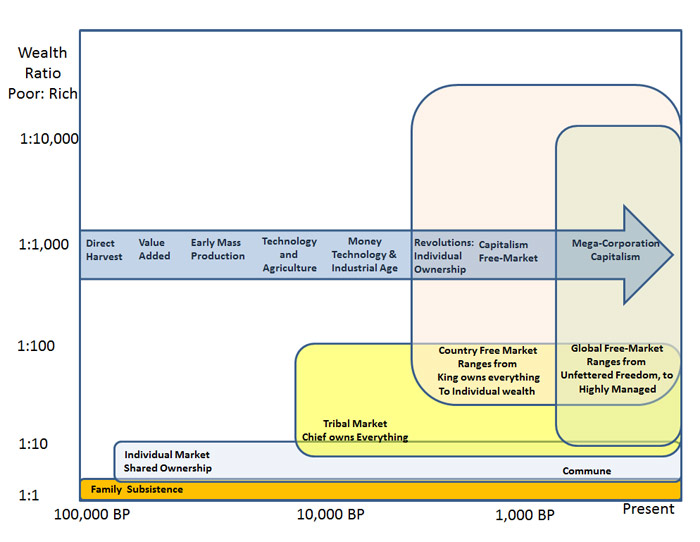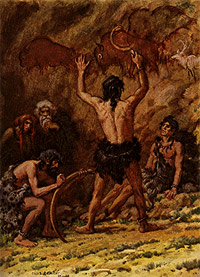 Much has been made of the relationship between evolution and the economy, especially at the early stages of modelling the free market and again in very recent years. While beneficial use can be made of the principles of evolution in economic systems, they are not suitable for understanding or managing economies in the time scale of human life spans or even over the span of time a given country or regime survives.
Much has been made of the relationship between evolution and the economy, especially at the early stages of modelling the free market and again in very recent years. While beneficial use can be made of the principles of evolution in economic systems, they are not suitable for understanding or managing economies in the time scale of human life spans or even over the span of time a given country or regime survives.
Natural evolution is a spontaneous process that has no predetermined milestones or end points. The progression of evolution is completely dependent on the random variation that occurs at the genetic level in the cells of the organisms. The basic genetic code combined with these random variations, usually small, determine the characteristics of individuals in the population. Natural selection, often characterized as the “survival of the fittest” operates by eliminating individuals or reducing the numbers of progeny from the group who do not compete well against other individuals. We see these changes as gradual shifts in the characteristics of a species or of losses, gains, and changes in species composition over vast periods of time. Noticeable species changes from evolution in nature are usually not apparent in time spans less than thousands or tens of thousands of years. The natural selective forces act on the DNA are mediated by the individuals and are seen as species changes.
Here is an example of how we might visualize the evolution of the economy using an evolutionary model. In this example the “X” axis is time beginning about 100,000 years ago. The “Y” axis is the spread between rich and poor. As you can see the number of types of economic systems rose form one (subsistence) to at least five, all of which continue to exist to some degree or other.
 Over time some types become dominant, others take over with competitive success. Within each of these major types (Families?) of economic systems, there are many smaller subsystems (Genera?), and within the subsystems there are special forms that are typical of specific regions (Species?). Just like natural evolution, each new economic form or species derives from the previous form and inherits its basic characteristics, but can lose or gain specific characteristics by which we can identify it. In today’s well developed economy, and within the Family of “capitalism” there are many species. At one extreme the Chicago school of unfettered free market economy wherein the government has only a role to enable the corporations. In the middle a managed capitalism (espoused by Keynes) and at the other extreme several forms of socialist capitalism. Some of these species have offshoots of economic species such as unions that compete for the wealth by closing off access to broader ranges of resources by the more typical corporations.
Over time some types become dominant, others take over with competitive success. Within each of these major types (Families?) of economic systems, there are many smaller subsystems (Genera?), and within the subsystems there are special forms that are typical of specific regions (Species?). Just like natural evolution, each new economic form or species derives from the previous form and inherits its basic characteristics, but can lose or gain specific characteristics by which we can identify it. In today’s well developed economy, and within the Family of “capitalism” there are many species. At one extreme the Chicago school of unfettered free market economy wherein the government has only a role to enable the corporations. In the middle a managed capitalism (espoused by Keynes) and at the other extreme several forms of socialist capitalism. Some of these species have offshoots of economic species such as unions that compete for the wealth by closing off access to broader ranges of resources by the more typical corporations.
To sketch the evolution of these major family groups, I chose to begin about 100,000 years ago because that was a time when our own human species experienced a near extinction event. It is estimated that only about 15,000 of us were left alive at the time. (And to those who have already asked me: no these are not “knuckle-draggers”, these are people just like you and me).  Previously we had lived as nomadic family groups, interacting with other groups to a limited extent. At the crunch period we were all in South Africa. Thus in fact every single person on the face of the earth has his or her ancestors in South Africa. The first evidence of people acting in cooperative tribes rather than nomadic family groups was found here, probably because of the limited resources available. This shift to a tribal format created the environment for trading between tribes. We could characterize this as a shift from subsistence to a barter economy based on individuals.
Previously we had lived as nomadic family groups, interacting with other groups to a limited extent. At the crunch period we were all in South Africa. Thus in fact every single person on the face of the earth has his or her ancestors in South Africa. The first evidence of people acting in cooperative tribes rather than nomadic family groups was found here, probably because of the limited resources available. This shift to a tribal format created the environment for trading between tribes. We could characterize this as a shift from subsistence to a barter economy based on individuals.
The time frame differs in different regions, but as the climate changed the people were able to reproduce and migrate throughout Africa. By 40,000 years ago, the nomadic patterns slowed and we see the first evidence of small artisanal factories where one or more skilled people make tools or parts of tools to be used by others.
By 12,000 years ago, the nomadic pattern was being replaced by a settled systems of towns and cities supported by the first of the agricultural communities, the transition from the paleolithic to the neolithic. This very early “mass production” heralded the arrival of the ability for larger groups of tribes getting together in a market system to barter not just as individuals, but as tribe-to-tribe. One consequence of this approach is that he concept of ownership becomes important and in many extant tribal systems, the norm is for the chief to own everything on behalf of the people.
The “y” axis presents on the chart an estimate of the range of wealth between the lowest 10% and the top 10% of the population. In family subsistence no one is really more wealthy than anyone else — everyone shares the resources. Once there is trade between nomadic individuals, it is possible to have one person or family perhaps ten times a rich in resources as another family. But in a nomadic existence when wealth is only what you can carry, the incentive to acquire is very limited. It took until the climate changed enough for agriculture to be a reasonable alternative to a nomadic existence. At this stage, there is now the potential for a chief or “Big Man” of a tribe to be quite “wealthy,” perhaps as much as 100 times as great as others. It is also unlikely that the ratio will be less than about ten times differential.
Approximately 6,000 years ago the planet began another warming trend.This was the beginning of the development of great civilizations, the establishment of monetary systems, and a greater emphasis on technology, all made possible by increased agricultural productivity. Because of the burgeoning size of the civilizations, enormous wealth could be accumulated and trade commenced between entire countries. Individual rights to ownership were limited by the state in most countries. In fact in many countries the state considered that it owned everything, including the people. The consideration of people as just labor rather than important individuals presages the situation today. Most rulers treated the majority of their citizens as slaves or serfs. They also routinely used prisoners of was as slaves – a commodity. When the differential between rich and poor reaches 1:1,000 political systems become unstable. At greater than 1:100,000 revolution is almost certain. And that is exactly what happened in many of the great empires. Revolution reduced the empires to a much more egalitarian economic system and in general allowed individuals to accumulate wealth in private transactions. The beginnings of free markets and accumulation of wealth by individuals was firmly established at the expense of Kings, Emperors, and other rulers.
In the 1600s, John Locke enunciated the principle that a person is born according to a “natural law” with the right to life, health, liberty, and property. He went on to maintain that government is there to protect those rights and ensure a fair treatment within those rights. People essentially form a compact with the government and if the government fails to do a good job of the compact or worse tries to take away any of the rights, the government becomes illegal. These principles underpin the concept of capitalism in which a group of people can combine their capital to more effectively control the production, distribution and exchange of wealth amongst the entrepreneurs. The rest of the people are considered to be an expendable resource to carry out labour unless they can be replaced by cheaper labour or machinery. In the late 1800s and early 1900’s an interest in linking the newly discovered principles of evolution to the economy (both spontaneously developing systems) grew to a high point when Milton Friedman linked the two using the phrase “survival of the fittest.” He incorrectly assumed the result of such competition on an evolutionary principle would result in a highly diverse nicely partitioned system as is found in nature. His error was time scale. He attempted to use evolution in a time scale where the principles of competition are more appropriately aligned to “ecology.” Unfortunately for all of these modellers, the concepts of ecology had not been enunciated at the time. Ecology does operate in a time frame that is suitable for modelling the management of the economy where evolution does not.
In the 1800’s the modern industrial revolution created as system in which corporations began to exploit the labour and the ratio of rich to poor approached the critical limits and revolution took place again. In this case, it was in the form of a type of organization — the union — that limited access by the corporations to cheaper labour, and enforced this by strikes which are essentially managed mini-revolutions. We are in the last stages of what I characterize as a mega corporation free market system. This system drives the wealth ratio towards the unstable levels.
So this is the nature of evolutionary forces acting on the economy. While these evolutionary forces do act on the economy in the time scale of a person or a corporation or a country, for the most part the changes are so small within that time scale that they are not visible. For visible changes in short time-spans, we need to think about the economy in ecological terms not evolutionary terms. The “ecological” structure of an economic system — that is the distribution of species in a given economic region (“econo-zone”?) one needs to work with ecological principles of competition, and those are not the same as evolutionary principles of competition.
If there is a prediction to be made, a spontaneous new species of capitalism is probably developing as a result of the Internet allowing individual small entrepreneurs to compete successfully against the large corporations because the large corporations can no longer control the production and distribution of the products. How this will play out in the long term with the interests of current mega fauna equivalents of the animal world (major corporations) influencing the socio-political environment remains to be seen. Just like in natural evolution, the selective forces of competition work on the DNA of the entrepreneurs so that individual entrepreneurs win or fail, and we see the results expressed as the rise and fall of corporations. Will these mega corporations be similar to the mega fauna of the past? Are they the giant dinosaurs of the economic world? And if so how long will they roam the earth before giving way to the equivalent of mammalian insectivores so many millions of years ago.
